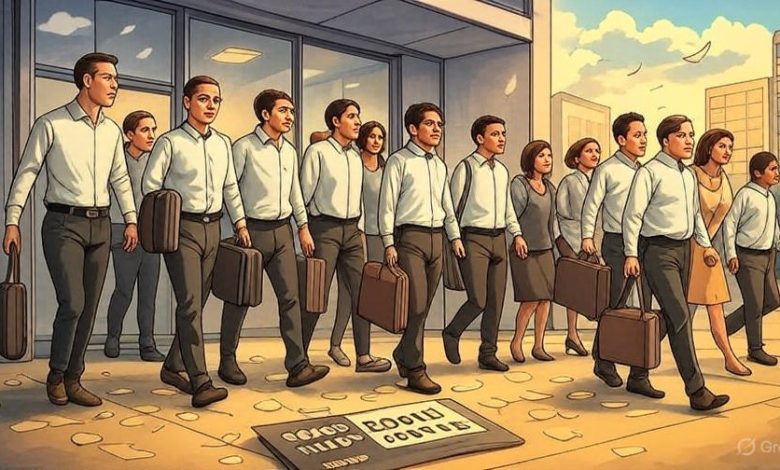
In just six months, over 1 lakh jobs have been lost in 2025—a staggering number that reflects the fast-evolving priorities of global corporations. With over 76,000 cuts in the tech sector alone, the year has been marked by economic uncertainty, cost-cutting initiatives, and a heavy push toward AI integration. From multinational tech firms to manufacturing giants and digital service providers, layoffs have spared no industry.
Companies are restructuring for speed, efficiency, and automation. Human roles in support functions, mid-level management, HR, and even some technical domains are being downsized, replaced, or made redundant. Below is a company-wise breakdown, followed by insights into the broader industry trend.
Major Tech Company Layoffs (Pointwise Breakdown)
1. Intel – 25,000+ Jobs Cut
- Impact: 20% of global workforce
- Key Departments: Foundry division
- Reason: Restructuring under new CEO Lip-Bu Tan
2. Panasonic – 10,000 Job Cuts
- Impact: 4% of workforce
- Regions Affected: Japan & global
- Focus: Moving from traditional products to AI
3. Microsoft – 6,500+ Layoffs
- Departments: Engineering, marketing, legal
- Layoff Strategy: Multi-phase; another round in July
- Goal: Improve engineer-to-manager ratio
4. Meta – 3,600 Job Cuts
- Impact: 5% workforce
- Teams: Facebook, VR, logistics
- Focus: Eliminate “low performers”
5. Google – Multiple Rounds
- Roles Lost: 200+ in business; cuts in Android, Chrome, HR
- Reason: Streamlining using AI tools
6. Amazon – 14,000+ Jobs Gone
- Targeted Units: Alexa, Ring, Zoox, upper management
- Strategy: Flattening manager-to-worker ratio
7. Blue Origin – 1,000+ Layoffs
- Impact: 10% of workforce
- Departments: Engineering, R&D
- Timing: Post–New Glenn rocket launch
8. IBM – 8,000 Layoffs
- Primary Cuts: HR roles
- Reason: AI automation replacing administrative functions
9. HP – 6,000 Jobs Axed
- Plan: “Future Now” strategy
- Focus: Shift toward AI PCs and HPC
10. Block – 931 Jobs Lost
- % of Workforce: 8%
- Note: 800+ open roles removed; 200 managers reassigned
11. CrowdStrike – 500 Layoffs
- Reason: Recovery from major Windows bug incident
- Focus: Reduce redundancies, speed up ops
Not Just Tech: Non-Tech Companies Cutting Jobs Too
Even outside the tech world, massive layoffs are becoming common. Companies in auto, retail, finance, and digital content are trimming headcounts:
1. Nissan – 20,000 Job Cuts (By 2027)
- Reason: China sales dip, factory downsizing, tariff impacts
- Outcome: Closing 7 factories, reducing global output
2. Salesforce – 1,000+ Layoffs
- Note: Laid-off workers encouraged to reapply for AI-based roles
3. Workday – 1,750 Job Cuts
- % of Workforce: 8.5%
- Focus: Shift resources to AI hiring
4. Starbucks – 1,100 Corporate Layoffs
- Unaffected: Baristas and in-store roles
- Goal: Simplify operations and improve integration
5. Match Group – 325 Employees Let Go
- % of Workforce: 13%
- Purpose: Accelerate product launches and reduce layers
6. Automattic – 16% Workforce Cut
- Brands Impacted: WordPress, Tumblr
- Focus: Profitability amid content market slowdown
7. Porsche – 1,900 Jobs to be Eliminated
- Timeline: By 2029
- Goal: Streamlining and faster EV development
What’s Causing So Many Jobs to Disappear?
1. AI Adoption & Automation
Companies are actively replacing administrative, HR, and even technical roles with AI agents and tools.
2. Cost Reduction
With inflation and rising operational costs, companies are cutting jobs to meet margin goals.
3. Performance-Based Filtering
Many CEOs—like Zuckerberg—are openly targeting “low performers” to streamline teams.
4. Shift Toward Lean Structures
There’s a noticeable move to reduce middle management and flatten organizational layers.
5. Global Economic Pressure
Declining consumer demand and geopolitical uncertainty continue to affect revenue forecasts.
Layoff Trends by Month (Jan–June 2025)
| Month | Estimated Layoffs |
|---|---|
| January | 14,000+ |
| February | 21,000+ |
| March | 19,000+ |
| April | 24,000+ |
| May | 16,000+ |
| June | 12,000+ (ongoing) |
What’s Next for Workers?
With so many jobs lost in 2025, professionals must now look toward upskilling and adapting to the AI economy. Demand is rising in fields like:
- Generative AI & ML
- Cybersecurity
- Product management
- Data science
- Cloud engineering
Companies are hiring—but only for roles that directly align with future-readiness.




